Today I want to talk about specific tactics about selling your books or creative work. If you are a writer or artist struggling to figure out how to get your work out there (and sold!), this is for you. I’ll be framing the examples squarely on the book industry, but much of it applies to other creative fields. Okay, let’s start off with a doozy:
Nothing sells books.
Meaning: no specific strategy is widely known to sell books. For any recommendation you hear from one person of a tactic that seemed to sell books for them, you will read another detailed post from a different author who felt they wasted their time and energy on it, with zero results.
What many authors are left with is a laundry list of book marketing strategies that they move through, quickly determining that each of them wasn’t the magic idea they hoped it would be. The result is that it would be easy for a writer to justify that:
- Social media doesn’t sell books
- Online events don’t sell books
- Book readings don’t sell books
- Newsletters don’t sell books
- Podcasts don’t sell books
- Collaborations don’t sell books
- Social media ads doesn’t sell books
- Print ads don’t sell books
- … and so on
Why? Because they feel frustrated and powerless in understanding where to spend their limited resources. If none of these tactics are guaranteed to help you sell a single copy of your book, does that mean you should skip them?
Nope.
I have been revisiting some older essays I wrote, and I found this one from my trip to BookExpo in 2015. This is a trade show for the publishing industry, where publishers, distributors, licensors, booksellers, librarians, and many others come together to do business.
Because publishing is a business.
What drives the show is people wanting more exposure for their books. Around this same time, my friend Emma Dryden (who works with children’s book writers and illustrators) shared an analysis she did on how many people may touch a book inside a traditional publishing process. Obviously, each publisher and book is different, so your mileage may vary.
Emma framed this as, “Publishing personnel who each typically read and/or work on an author’s book in some capacity before, during or after the book is published.” Get ready to scroll:
- Publisher
- Deputy Publisher
- Editorial Director
- Editor
- Editorial Assistant
- Creative Director
- Art Director
- Designer
- Production Director
- Production Manager (oversees production: paper, printing, binding, specs, etc.)
- Production Assistant
- Pre-Press Operator
- Managing Editor
- Production Editor (oversees and coordinates schedules, copy editing, etc.)
- Assistant Managing Editor (aka Copy Editor)
- Marketing Director, Trade
- Marketing Associate
- Marketing Director, Education/Library
- Digital Marketing Coordinator
- Marketing Assistant
- Ad/Promo Director
- Advertising Director
- Publicity Director
- Associate Publicist
- Subsidiary Rights Director
- Subsidiary Rights Manager
- Sales Director
- National Accounts Director
- National Accounts Manager
- Online National Accounts Manager
- Sales Associate
- Demand Planning Director
- Demand Planner
- Reprints Associate
- General Manager (oversees business: P&Ls, finances, royalties, etc.)
- Financial Analyst
- Business Manager
- Contracts Director
- Contracts Manager
- Royalty Manager
- Royalty Assistant
Her footnotes:
+ PLUS Sales Representatives (independents, chains, online, chains, special sales)
+ PLUS Other assistants and associates within each department
+ PLUS Permissions Director, Legal Counsel, and other personnel who may not read/work on every book, but who are on staff to assist when required.
In our chat she mentioned that many new authors may know nothing of this process, and when trying to emulate their heroes, eschew the idea of having to embrace various elements of the publishing process. Yet, to some capacity, each author goes through their own version of these parts of the process.
In walking the show floor at BookExpo that year, I was thinking about the elephant in the room that some writers either don’t know about, or don’t want to know about: that to write is one thing (it is the first thing!); but to sell, is another thing entirely.
We like to think that a good book sells itself. Looking around at the enormous show floor at BookExpo, I had to consider otherwise.

For a writer, if they want their book to find an audience, to ignore the marketing process is to ignore how books have found readers for generations. As I journeyed through BookExpo, I considered: what are all of the sales and marketing tactics being used to sell books here? A partial list:
- I have to start with this one: the first great sales tactic to sell a book is to indeed write a great book!
- Location (the Javits Center in NYC is flashy, centrally located, and expensive)
- Booths and booth design (you see lots of different strategies here)
- Free books, including advanced copies of highly anticipated books that won’t be published for months.
- Costumes (yes, there were people in costumes promoting books)
- Autographs from authors
- Celebrities
- Swag: free stuff
- Posters & banners (some 30 feet tall)
- Panels, sessions, concurrent events. In some of these situations authors become teachers, but in all the person on the stage is facing their fear of public speaking. My gut is that many of them would classify themselves, to some degree, as an introvert.
- Buzz panels — where certain books are pitched more fervently than others.
- Contests and awards (some are simple contests within a booth, but others are juried awards)
- In-person meetings (loads of these, with some huge portions of the show floor segmented off for these)
- Sales material, sales pitches, demos, etc.
- Social media (promoting hashtags, etc.)
- Parties (lots of these in the evening, it’s not uncommon for someone to try to pop into multiple parties on a single night.)
- Free alcohol (yes, they actually roll out these mobile bars onto the show floor at the end of some days)
- Free food, such as promotional cupcakes with book covers on them.
- Lots of messaging, links, business cards, and other ways to follow up after the show.
- Singing (yes, I’m serious)
- Nonverbal communication, such as smiling, body posture, and other cues
- Nice clothes. There I said it: we all had to tuck in our shirts for this event.
One huge thing worth noting: many of these are age-old sales tactics, as relevant in 1975 or 1925 as they are today. Even though BookExpo as an event has an uncertain future, these same tactics will remain — just in a different guise.
I speak to a lot of writers and creators who struggle to connect their book with an audience, and are frustrated by that. Yet when I look around at BookExpo, I see a massive effort to do the same thing. This is what they looked like in 2015:
Enormous banners in the glass atrium:
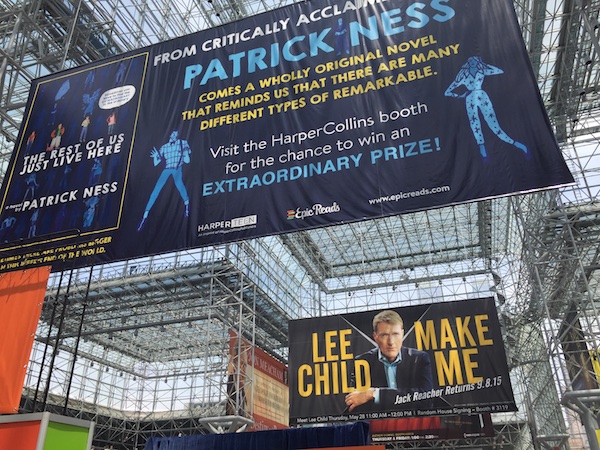
What is so interesting is that the Wimpy Kid series is a runaway success. Yet, the publisher still feels that a 30 foot tall banner is needed:
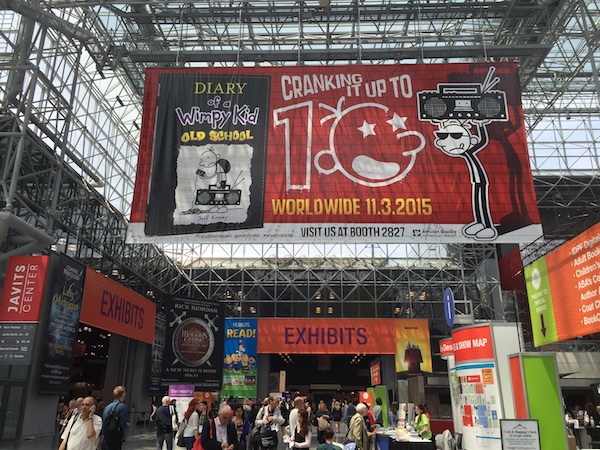
The woman on in the center is protecting advanced reader copies… there is a long line waiting to grab them:

They couldn’t open these boxes fast enough, advanced copies of City on Fire:
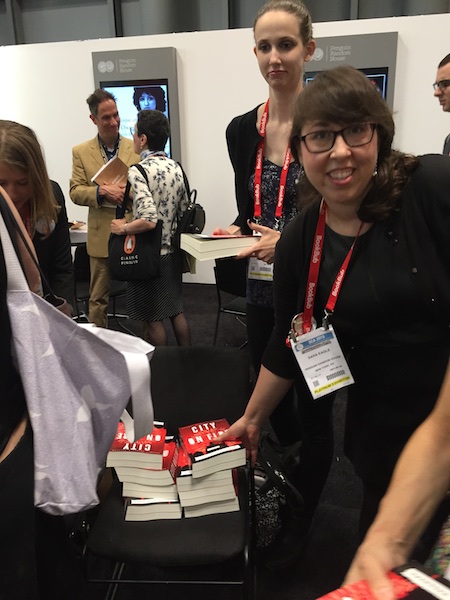
Evidently, a lot of attendees bring an empty suitcase, and then spend the show filling it up with free books they receive:

There is a huge autographing area. In this photo, we see Bernadette Peters signing on the left:
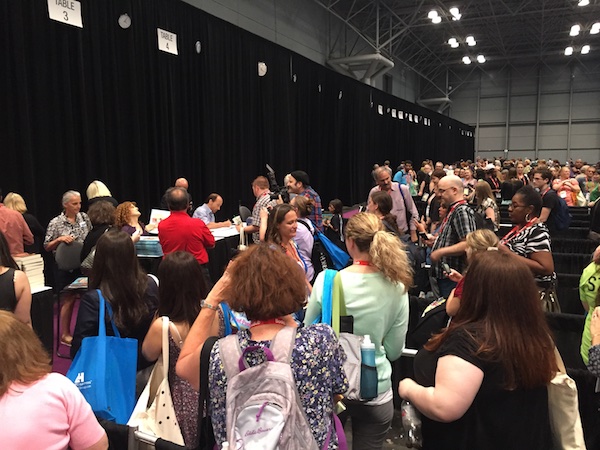
There are also in-booth autographs. Here we see Julianne Moore:

There were costumed characters:

And costumed authors:
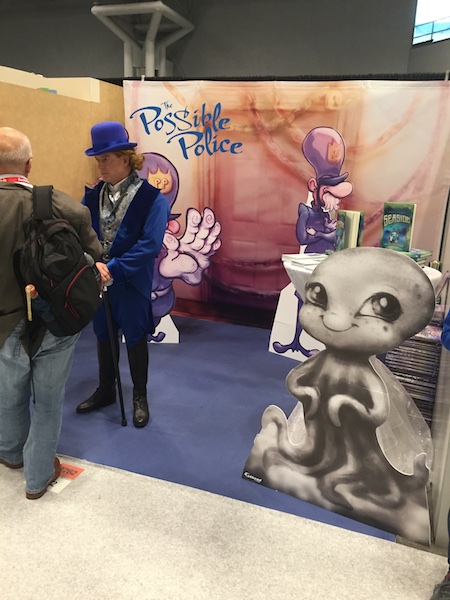
Cupcakes being readied to be given away:

Publishers have their own large private meeting areas. This one is for Penguin Random House:
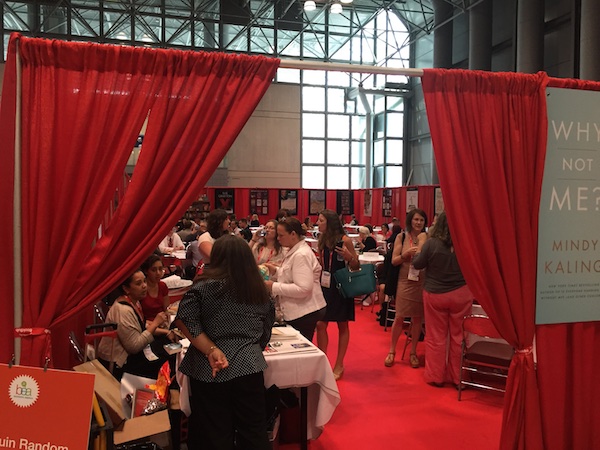
The American Booksellers Association created an Indie Bookseller lounge:
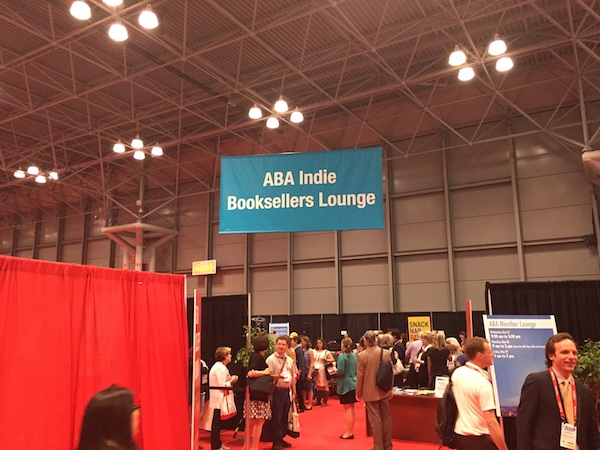
Here is a panel discussion featuring a writer and illustrator for some of Marvel’s Star Wars comics:

Of course, there were rows and rows of booths — so big that you needed a map to find anything:

Penguin brought in a branded book truck:

There were singers:

Free foam shields for a Rick Riordan giveaway:
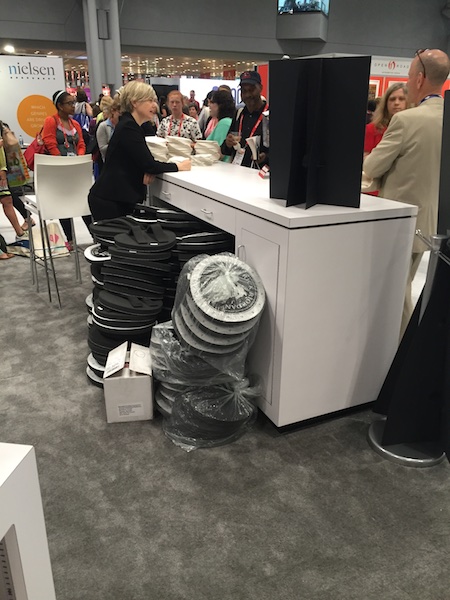
And so much more that I didn’t capture in photos. What are the lessons that an individual author can take from this? Well, let’s look at one book I was able to get, an advanced copy of City on Fire, which seemed to be highly anticipated at the show:
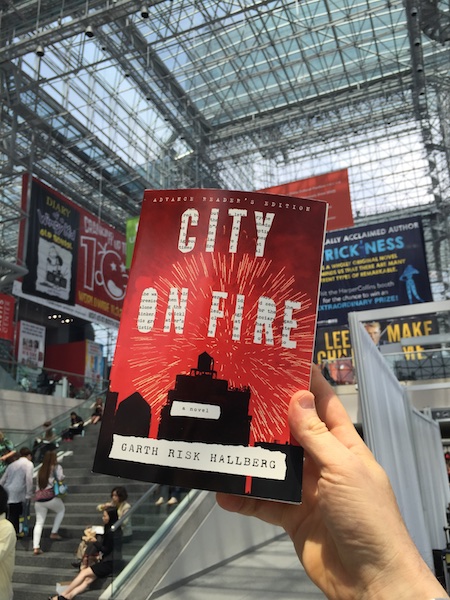
As I started to read it on the train ride home, I noticed this inside the back flap, a long list of “Marketing Plans”:
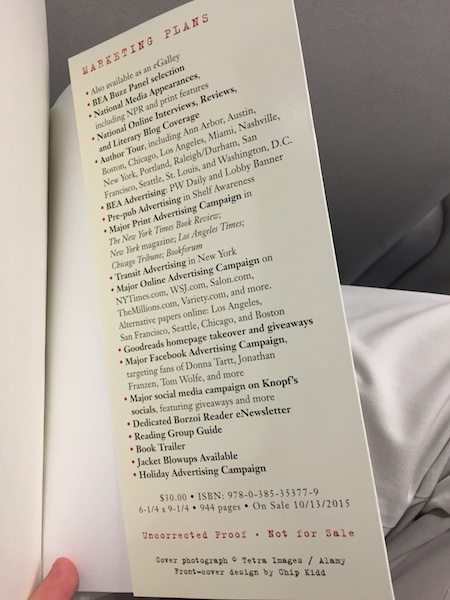
The book wouldn’t be released for another six months, but there are already blurbs when you open the book, and a long list of major promotion that the publisher is planning.
Did any of these individual tactics — a specific costume, a specific cupcake, a specific banner — sell a single book? Likely not. But in total, it is fascinating to look at the scope of strategies the industry uses, and how combined together, they help spread the word about a book.
Today, we would add additional tactics to the list, of course, many of them being digital.
I keep all of this in mind as I work with writers and creators each day, helping them get clarity on how to present their work, identify their ideal audience, engage them, and launch their books. This work is multifaceted, and can be filled with joy. It can speak to who you are authentically, and not force you to be promotional in a way that feels uncomfortable.
Marketing is sharing, and the opportunity that we each have is to share what we create in a way that feels meaningful.
So many of the examples I shared in this post had nothing to do with social media. I’ve written that you can have a platform without social media, but you have to be open to the kind of work involved with that.
For a great primer to get started on your own marketing, check out my book Be the Gateway: A Practical Guide to Sharing Your Creative Work and Engaging an Audience, or the PDF and 2+ hours of video walking you through my Creative Success Pyramid.
Thanks!
-Dan
